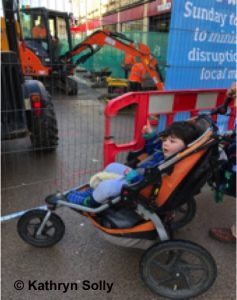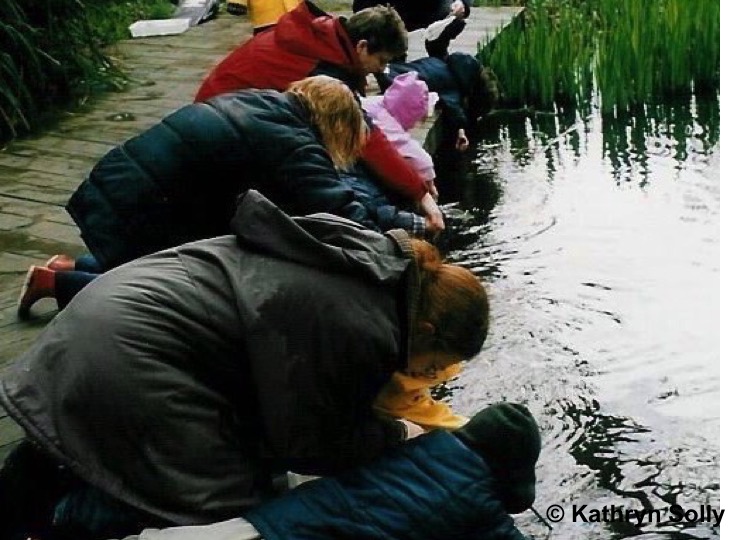Continuing with a previous ECO blog theme of harnessing the incredible richness of the locality and community that wraps around every early years setting, Kathryn Solly shares the ‘Expeditions’ practice that developed over several years during her time as ‘head learner’ at Chelsea Open Air Nursery School (COANS) in central London. This is an additional layer of outdoor provision that just cannot be offered in even the most extensive onsite nursery garden – and is of course particularly important and valuable when onsite space is limited in any way.
Kathryn contributed a longer piece on Expeditions for the ‘Exploring the Wider World’ project resources available on Early Education’s website, called Moving from a ‘jolly’ to a deep and meaningful experience. If you have a subscription for Nursery World magazine, Anne O’Connor’s 4-page feature in this months issue explains why visiting local spaces is important – and how to navigate doing so in the wake of lockdown.
You might also be interested in the chapter on ‘Outdoor experiences beyond the garden’ in my book, Playing and Learning Outdoors: the practical guide and sourcebook for excellence in outdoor provision and practice with young children (3rd edn. Routledge 2020).
Kathryn is currently preparing her second book with Routledge, Leading Children’s Learning Outdoors from Birth to Seven’.
What a wonderful world outside by Kathryn Solly
As the former Headteacher of Chelsea Open Air Nursery School I was aware of how its founder Dr Susan Isaacs had used the locality to enrich children’s learning possibilities. Isaacs took the children out on what she termed “excursions” which were an expanding range of visits “taken at all seasons of the year.”
When I started we needed to review the procedures used when taking the children out into the community.
- We decided that going on visits had not had adequate educational rigor for the responsibility of taking young children out into London. We coined the word “expeditions” as it conveyed all the care, planning, and organisation needed to take young children out whilst enriching their learning.
- We redrafted our policy for taking children out into the community by ‘testing’ it on volunteer families who accompanied us as ‘helpers’ on expeditions, providing another perspective on their value and importance.
Diverse families started to value these explorations around their community with their child and developed a deeper sense of place by being within it. This led to greater security and stronger bonds to the place, and to them having more local pride. Every village, town and city in our country has places of interest but children need motivated and inspired adults to take them out and feed and nurture these genuine fascinations.
I define expedition as: “a journey into the world outside the school/setting which provides experience, exploration and interaction with new individuals, resources and opportunities. It must involve reasonable challenge and risk in order that the individuals concerned experience the ‘flow’ or thrill of learning alongside the realisation of the excitement of learning” (Solly, 2015).

Our expeditions included:
- Museums and galleries
- Shops
- The bank
- Underground station
- River and bridges
- Library and Town Hall
- Hospital
- Ecology Centre
- Theatre
- Parks and gardens
- Fire, police and ambulance stations
- Hotels and restaurants
- Places of worship.
Taking the children out was the opportunity to enhance their learning interests through small and focused interactional experiences, rather than an aimless wander around. For example:
- The group who were challenging us by flooding the toilets had the chance to meet the actor playing Thomas Crapper who invented the first flushing toilet and to explore the gallery ‘The Secret Life of the Home’ in the Science Museum.
- Another group of children who had become really interested in families were taken to see a display of wicker Asian elephants near the Serpentine. The display provided a rich opportunity to understand different families and some hands-on experience of scale, size and number.
- A single child’s interest in architecture was made real by exploring local churches, connecting with his own discoveries from books and construction blocks.
- Children with unique needs also benefitted as we were able to take them to extend their fascinations. One such expedition to the London Eye was for a child who was exploring rotation on a small scale.

How we planned and prepared
Planning questions:
- Who is the expedition for?
- When can I carry out a pre-visit and carry out a risk-benefit assessment?
- Where can we go to extend and enrich their learning?
- Why are we going there?
- Is it developmentally appropriate?
- Is it practical in terms of timing, weather, resources, access, transport and cost?
- How long will we need to spend there?
- How do we staff it?
- What to take with us?
- Who will accompany us (adults)?
- What experiences do we provide before and after the expedition?
- What permission slips/letters are required.
For adults, whether staff or parents, the benefits of expeditions need to be clear:
- Learning to observe the child learning
- Valuing everyone’s input and ideas
- Expeditions being a learning process with different impacts, results and effects on different individuals
- The importance of genuine partnership
- Learning to learn alongside the child rather than being an ‘expert’
- Being organised and prepared for different eventualities to cope with the unexpected
- Creating treasured memories
- The fun of learning, challenge and risk-taking
- Understanding that risk is an essential part of life
- Experiencing awe and wonder.

Going out into the world around is very beneficial for young children but nothing can be guaranteed. Expeditions allow children to travel into the adult world and explore different challenges in reasonable safety. Allow plenty of time as hurrying is the main cause of accidents since young children walk slowly, wish to look, talk and point out things. Expeditions provide the movement from comfort zone to challenge zone, and build self-concept and self-esteem alongside other learning. They are springboards for learning which if designed carefully can really aid children’s learning as well as build their real understanding of risk benefit and so much more.
The deep value of excursions
Other beneficial learning came from a wide variety of visitors, who were different role-models providing a range of benefits:
- New and positive relationships and interactions
- Building community awareness and understanding of new concepts and aspects of learning
- Developing an understanding of the world of work
- Building further upon concepts of respect, inclusion and diversity
- Engaging in interactions with new and less familiar voices.
The visitors included Chelsea Pensioners, Park Rangers, a poet, an MP , other civic dignitaries, doctors, dentists, vets and other health practitioners, hairdressers, musicians, storytellers and dancers from a wide range of cultures. Some visitors were a one-off whereas others returned frequently having fulfilled the necessary DBS requirements.

Remember:
- walking has huge benefits for young children for health, well-being, independence, and freedom as well as being fun and social interaction
- keep a tight focus on your area of interest and do not get side-tracked
- two-year-olds will find ‘treasures’ along the way, the threes will be fascinated by the ‘treasures’ as well as travelling to and fro on the ‘journey’
- 3 and 4 year-olds can be more involved in planning the journey and risk-benefit assessments too. 4-5 year-olds can identify and make sound decisions about possible problems and risks and how to alleviate them.
By trying to involve everyone in these simple local community experiences also gives them ideas of how to enrich their learning so everyone learns and benefits.
References
Isaacs, S, (1936) (First published 1930) Intellectual Growth in Young Children. London: Routledge & Kegan Paul.
Solly, K. (2015) Risk, Challenge and Adventure in the Early Years. Abingdon: Routledge.
All photographs are © Kathryn Solly. Images must not be used without written permission from Kathryn Solly or Early Childhood Outdoors.


I love this article and the commitment to following children’s fascinations. There is just so much available in our local communities to explore with young children and it is great to share this approach with parents who may just need a nudge to discover that they too can have expeditions to a building site, museum, woodland etc that will not cost them a fortune in entrance fees and will fully engage the interest of their child.
I also think we must value unplanned walks where fascinating things can be discovered including the different colours, textures, patterns, shapes and signage to be found in the built environment, unexpected events such as a downpour of rain, building work, a post box being emptied, flowers growing between cracks in the pavement. To respond in the moment to children’s questions , comments or desire to stop and observe is often missed when there is a need to get to a planned destination. To slow down and appreciate such wonders on an apparently aimless walk can be as thrilling as a planned excursion. So many of our children, especially those who are rushed between home and setting in cars, rarely experience the joy of ambling, stopping, gazing and pondering.
It is interesting that one of the benefits of lockdown has been that so many people have walked around their neighbourhood for their daily exercise and discovered an abundance of interests places in the vicinity of their homes that they had been totally unaware existed.
Thank you Kathryn for this brilliant article, it should be shared far and wide…
I totally agree with you Ann that unstructured walks, where the walk itself is the ‘destination’ and the pace and attention is determined by the children’s interests, are of particular value.
My daughter as a two year old taught me much about the incredible potential and value of this approach. It’s best done in very small groups in my experience.
Thanks for adding this perspective. I’m thinking that a follow-up blog on this from you would be perfect!
Well yes, it is certainly a subject I am passionate about and you have joined us on a number of unstructured walks in the woods over the years when unexpected events have provided some magical moments! So yes, hopefully I can put something together over the Summer and gather some of the stunning photos that have been taken by chance during the weekly unplanned expeditions that are such an important part of life at Sandfield Natural Play Centre.
☀️
Marvellous – this will make a very interesting addition to our ongoing theme of exploring beyond the garden gate.